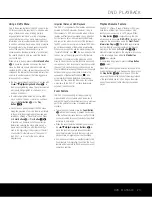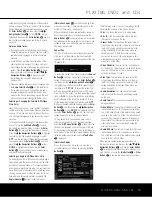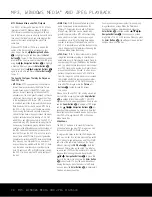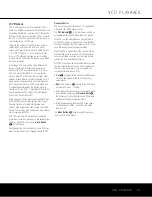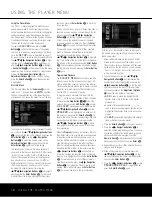
14
SETUP AND CONNECTIONS
SETUP AND CONNECTIONS
• If your television, monitor, projector or video display
has standard composite and S-video connections
only, connect one or the other (but not both) either
to the matching video inputs on your receiver or
processor, or directly to the inputs on your television
or other video display.
• When both composite (yellow) and S-video jacks
(but not component inputs) are available on the
video display, we recommend using the S-video
connection for higher video quality.
• If your receiver or processor has video switching
capability, we recommend that the composite or
S-video outputs of the DVD 31 be connected to
the receiver or processor, along with the output
of other video sources in your system, such as a
VCR and cable or satellite receiver. This simplifies
the operation of your system since the receiver
or processor will switch multiple sources and
feed the selected output to the display.
• If your television, monitor, projector or video display
has component video inputs, we strongly recom-
mend that you connect the Y/Pr/Pb (green/red/blue)
video output jacks on the DVD 31 to the matching
video inputs on your receiver or processor, or
directly to the inputs on your television or other
video display.
• If your receiver or processor has component
video switching capability, we recommend that
the video outputs of the DVD 31 be connected
to the receiver or processor, along with the out-
put of other component video sources in your
system, such as an HDTV tuner or cable or satel-
lite receiver. This simplifies the operation of your
system since the receiver or processor will switch
multiple sources and feed the selected output to
the display.
• If your video display is compatible with high-
resolution video signals, be certain that the
connections are made to the input jacks on the
display marked “HD Component,” if available.
• If your video display is compatible with high-
resolution video signals, you may need to
configure the input settings on the display for
use with “480P” input signals.
• If you use the component video outputs with
a video display that is compatible with high-
resolution video signals, the DVD 31’s video
output should be changed from Interlaced to
Progressive, as shown on page 20.
• When the component video outputs are used, we
recommend that you also connect the standard
composite or S-video outputs to your receiver or
processor so that standard-rate video signals are
available for use with the multizone or record
outputs, where applicable.
240
240
31
TV/Video Display
or
A/V Receiver
To power outlet
(AC 120V/60Hz)
Y
Pr
Pb
To composite video input
connector (yellow)
DVD 31
Video Display Connections
IMPORTANT NOTE:
Make certain that any device
being connected, including the DVD 31, your receiver
or processor, and your TV or video display, are turned
off whenever you make connections between products.
NOTES:
• If an S-video or composite video connection is
made either as your primary video connection or in
addition to a component video connection for use in
feeding a multizone system or recorder, note that
you may make either type of connection, but not
both. Only one type is needed.
• When video connections are made to an A/V
receiver, surround processor or other device that
switches the video signals, make the connections
between that device and your video display in
accordance with the instructions for that product.
Depending on the capabilities of the receiver,
processor or other switcher, you may need to
make both composite or S-video and component
video connections.
To S-video
input connector
To Y/Pr/Pb
component connectors
DVD 31 (120V) OM 6/25/04 11:40 AM Page 14























